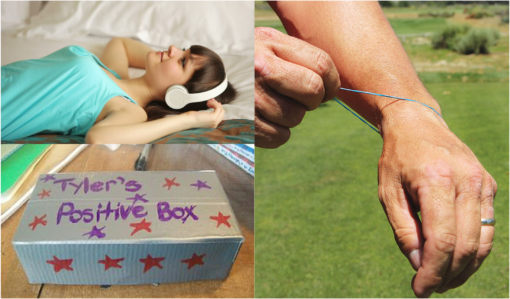Self-harm or self-injury is the action of deliberately hurting your body. You or someone you know may sometimes self-harm as a way to cope with strong physical or emotional pain and distress. Self-harming behaviour however, is treatable. Many people who self-harm keep it a secret, so it can be difficult to recognise. Trust your instincts, especially if you think someone you know is distressed or in trouble.

10 Ways to be Prepared and Reduce Self-Injury
1) Create an Emergency Kit. Place positive things in your kit like photos of people you love, notes to yourself or from friends or family, a journal for writing, markers or art supplies for artistic expression, an inspirational poem, beloved stuffed animal, upbeat music, favorite scents, things like that.
2) Use Positive Imagery. Visualise yourself moving through your painful moment without self-harming. Research shows that using positive visualisation can keep you in the moment, which is a key tool for recovery.
3) Hold Your Ground. Sensory Grounding experiences like holding something soft, listening to soothing music, drawing or writing, for example, can interrupt the trance-like state that often comes when you self-injure, shifting you towards more positive behaviours.
4) Reboot Your Mind. Reframe your thoughts toward helpful statements like, “Who am I really mad at?” or “What is setting me off?” or “I am safe and I am in control.” These can re-orient you to the here and now.
5) Know Your Triggers. Become aware of what issues bend or break you. Try to dilute your exposure to them, and call upon others to help you move through them. Remind yourself that you can emerge from them successfully.
6) Take a Detour. Reroute self-injury by using less severe forms of sensations. Holding an ice cube, tearing or shredding paper or a sheet, snapping a rubber band against your skin, sucking a lemon peel are ways to dilute the need to experience pain.
7) Move Your Body. Consider the adrenaline rush of running, dancing, holding a yoga pose, jumping rope to offset urges to self-harm. The rush of adrenaline has been known to produce the similar chemical surge that comes from self-injury.
8) Forgive Yourself. As you try to interrupt your self-harming behaviors, know that it may not come as easily some days as others. Should you find that you’ve lapsed into self-harming, remind yourself that change is a process. Learn to forgive and be kind to yourself as you start anew.
9) Be Supportive. If you know someone who may be self-injuring, offer support and try not to shame or criticize the behaviour. Thankfully, self-injury behaviors can be successfully treated. You can help your friend or family member by encouraging them to seek help. A professional such as one of our Psychologists can work together with you through these techniques and steps.
10) Consider Calling a Therapist. Remember that having an urge to self-harm is not the same as actually self-harming. If you can distract yourself from self-injury, you are well on your way to recovery. However if the urges win out and you find you don’t allow yourself to reduce your self-harm behaviours, consider working with a professional such as one of our expert Psychologists.
Reaching out and going down this path can really help you to investigate why and when you self-harm, so you can understand how to change the patterns of behaviour for a healthier future.
Information care of Psychologytoday.com/au

